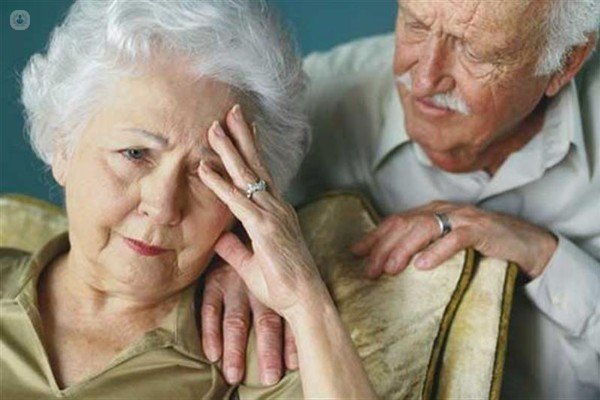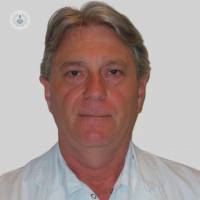Dementia:types, symptoms, causes and treatment
Written by:Dementia is a general term that encompasses a group of neurological diseases that affect the brain and cause deterioration of two or more areas of higher cognitive functions.

Its prevalence is estimated at 13’5 to 15 % of the population of 65 years. This percentage increases to 30-33 % older than 85 years and jumps to the 50-55 % older than 90 years. It is the most common cause of mental decline in old age.
About dementia there are several and varied definitions. An acceptable definition may be to the Lishman and Ron Teachers:“Global and acquired intellectual functions, memory and personality deterioration, which interferes with social and occupational functioning of the individual and which remains normal level. conscientious”
Types of Dementia
The disease Alzheimer is the most common dementia ( 40-50 % ), followed by the vascular dementia ( 15 to 20 % ) corpuscles Lewy (10-15 % ) and the rest (Parkinson's disease, Huntington's chorea, progressive aphasia, etc ) make up the remaining 10 or 15 %.
Sometimes it is difficult to distinguish one from the other, especially in media and advanced stages. In over 30 % of cases overlap each other, forming what is known as or multimodal mixed dementia.
Symptoms
The essential symptoms are:
1. Impaired memory, which generally is the predominant symptom.
2. Impairment of thought abstract and logical reasoning (inability to find and differences between related words if, difficulty in defining words and concepts).
3. Impaired capacity for judgment ( failure to take reasonable measures in terms of issues and problems related to work, family or social contacts. Also the ability to control impulses is affected ).
4. Disorder higher cortical functions:aphasia ( loss of ability to produce and understand language ), agnosia ( inability to recognize stimuli previously learned ) and apraxia ( dissociation between wanting to make a move and motor execution ).
5. Changes in personality:withdrawal, apathy, delusions of theft, jealousy ( uncontrolled jealousy), disinhibited behavior, etc.
6. Typically no level of consciousness disorder.
Causes
The dementias are classically divided into primary and secondary:
1. Primary which are those whose cause is in the brain (Alzheimer's disease, frontal dementia, frontotemporal dementia, etc. )
2. The secondary or pseudo dementia are those that are caused by hormonal deficit (hypothyroidism ), excess hormones ( hyperthyroidism or hyperparathyroidism) or reversible psychiatric disorders like depression, toxic ( poisoning by metals, renal or hepatic encephalopathy )
Also can be divided into senile/presenile depending on the age of onset, cortical/subcortical depending on which area of the brain is most affected, Reversible/no reversible depending on whether the entity that the underlying cause and damage have healing or not.
Some factors have been linked to an increased risk of developing dementia. The Age is the most important risk factor. The second most important factor is possess a first degree relative who suffers (risk 3’5 times greater for dementia ).
The single gene clear implicated in Alzheimer's Disease is the E4 allele encoding gene APOE.It is in the 10-15 % of the population European but in 45-50% of patients with Alzheimer's.
Head injuries, physical inactivity, consumption of toxic, low cultural level and personality troubles for adaptation are other factors studied that can facilitate the development of dementia.
factor is believed to may reduce the risk of dementia are:low/moderate alcohol consumption, the Mediterranean diet, antioxidants (vitamin E, vitamin C ) and unsaturated fatty acids. Practicing exercise regularly and exercise the mind also are activities that decrease the risk of developing dementia.
Treatment
To this day no effective treatment for dementia. Two groups of drugs are used routinely and almost as compassionate treatment:
1. IACE ( acetylcholinesterase inhibitors/act on via the acetylcholine ). Used in initial and intermediate stages of the disease.
2. NMDA ( non-competitive antagonists of N-methyl D-aspartate/via glutaminergic ). It is used in more advanced stages of the disease.
They can be used together in cases of young patients, in which the IACE has not taken effect, in addition to other drugs that are used to mitigate the effect of behavioral and psychological symptoms of dementia. The main ones are:
1. Benzodiazepines (especially for anxiety and insomnia )
2. IRS ( antidepressants such inhibitors selective serotonin reuptake, are used in cases of anxiety, agitation or apathy )
.
3. Farmacos antipsychotics ( used in low doses in the case of behavioral symptoms, delusional ideations, auditory illusions etc, but has not been shown to increase the quality of life of patients and reduce mortality )
In the case of non-pharmacological therapy, the first place is the psychostimulation:orientation to reality, cognitive stimulation, cognitive training, ADL training, reminiscence therapy, music therapy, aerobic exercise, overall combined stimulation.
Another interesting section is dedicated to wellness therapies caregiver. education, counseling, support programs, respite care, case management and family support therapy
In the case of dementia is very important to be advised by an expert to focus the disease holistic manner (bio-psycho-social ):make an accurate diagnosis, classification phase and develop a (usually multidisciplinary ) for the patient and family/caregivers, adapted to each stage of the disease.
therapeutic plan
The treatment plan should also consider cognitive ability, functional dependency, behavioral disorders and decision making, as not renewing driver's licenses, legal incapacitation, guardianship, living wills, limitation of therapeutic effort, etc.


